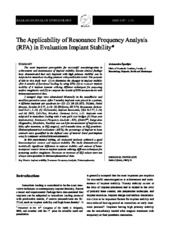Prikaz osnovnih podataka o dokumentu
The applicability of Resonance Frequency Analysis (RFA) in evaluation implant stability
| dc.creator | Špadijer, Aleksandra | |
| dc.date.accessioned | 2020-07-02T12:08:43Z | |
| dc.date.available | 2020-07-02T12:08:43Z | |
| dc.date.issued | 2005 | |
| dc.identifier.issn | 1107-1141 | |
| dc.identifier.uri | https://smile.stomf.bg.ac.rs/handle/123456789/1255 | |
| dc.description.abstract | The most important prerequisite for successful osseointegration is achievement and maintenance of implant stability. Recent clinical findings have demonstrated that only implants with high primary stability can be subjected to immediate loading protocol with predictable result. The purpose of this in vivo study was: (1) to determine the changes in implant stability after 6 months of functional loading by using RFA; (2) to evaluate implant stability of 4 implant systems utilizing different techniques for preparing surface roughness; and (3) to compare the results of RFA measurements with histomorphometrical data. 2 mongrel dogs were edentulated bilaterally in the mandibular and maxillary premolar areas. After 3 months, implants were placed in a pattern, 4 different implants per quadrant (n=32): (1) Mk III (RP), TiUnite, Nobel Biocare, Sweden D-3.75, L-10; (2) ITI-Screw, ITI TPS, Straumann, Switzerland D-4.1, L-10; (3) 3I-Osseotite, Implant Innovation, USA D-3.75, L-10; and (4) XiVE, Cell-Plus, Friadent, Germany D-3.4, L-11. Implants were subjected to immediate loading with 4 unit gold cast bridges (3-5days post implantation). Resonance Frequency Analysis - RFA, (Osstelltm, Integration Diagnostics, Sävedalen, Sweden) was used for measurement of implant stability after insertion, as ISQ surgical, and 6 months later, as ISQ prosthetic. Histomorphometrical evaluation - BIC%, the percentage of implant to bone contacts were quantified in the defined zone of interest (total peri-implant area) by computer assisted histomorphometry. In this experimental setting, all evaluated surfaces achieved a good bone-to-implant contact and implant stability. The study demonstrated no statistically significant difference in implant stability and amount of bone-to-implant contact between implant systems utilizing different techniques for preparing surface roughness. Decrease or increase of ISQ values were not always correspondent to histomorphometrical data. | en |
| dc.publisher | Udruženje stomatologa Balkana | |
| dc.rights | openAccess | |
| dc.source | Balkan Journal of Stomatology | |
| dc.subject | implant | en |
| dc.subject | stability | en |
| dc.subject | Resonance Frequency Analysis | en |
| dc.subject | histomorphometry | en |
| dc.title | The applicability of Resonance Frequency Analysis (RFA) in evaluation implant stability | en |
| dc.type | article | |
| dc.rights.license | ARR | |
| dcterms.abstract | Шпадијер, Aлександра; | |
| dc.citation.volume | 9 | |
| dc.citation.issue | 2 | |
| dc.citation.spage | 91 | |
| dc.citation.epage | 96 | |
| dc.citation.other | 9(2): 91-96 | |
| dc.identifier.fulltext | https://smile.stomf.bg.ac.rs/bitstream/id/127/1250.pdf | |
| dc.identifier.rcub | https://hdl.handle.net/21.15107/rcub_smile_1255 | |
| dc.type.version | publishedVersion |


